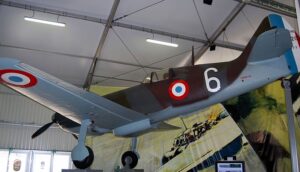Time Period: World War II
Country of Origin: United States
Type: Fighter Aircraft
Manufacturer: North American Aviation
North American P-64 Aircraft Overview
The North American P-64 was a single-engine fighter aircraft developed by North American Aviation in the late 1930s. The P-64 was based on the earlier North American NA-50, which had been developed for export to foreign countries.
The P-64 was powered by a Wright R-1820 Cyclone radial engine and had a top speed of around 300 mph. It was armed with two .30 caliber machine guns mounted in the fuselage and two more in the wings, and it could carry up to 300 pounds of bombs or other ordnance.
The P-64 was intended for export to foreign countries, but it did not generate much interest and only a small number were built. Some of the aircraft were used by the Philippine Army Air Corps during World War II, but they were quickly outclassed by newer Japanese fighter aircraft.
Despite its limited success, the P-64 was an important stepping stone in the development of North American Aviation’s line of fighter aircraft, which would go on to include the iconic P-51 Mustang.
North American P-64 Specifications
- Crew: 1
- Length: 27 ft 0 in (8.23 m)
- Wingspan: 37 ft 3 in (11.35 m)
- Height: 9 ft 0 in (2.74 m)
- Wing area: 228 sq ft (21.2 m2)
- Empty weight: 4,660 lb (2,114 kg)
- Gross weight: 5,990 lb (2,717 kg)
- Max takeoff weight: 6,800 lb (3,084 kg)
- Fuel capacity: 170 US gal (140 imp gal; 640 L)
- Powerplant: 1 × Wright R-1820-77 nine-cylinder air-cooled radial engine, 870 hp (650 kW)
North American P-64 Performance
- Maximum speed: 270 mph (430 km/h, 230 kn) at 8,700 ft (2,700 m)
- Cruise speed: 235 mph (378 km/h, 204 kn)
- Range: 630 mi (1,010 km, 550 nmi)
- Service ceiling: 27,500 ft (8,400 m)
North American P-64 Armament
- Guns:
- 2 × .30 in (7.62 mm) machine guns
- 2 × 20 mm cannons (Located in pods beneath each wing)
- Bombs: 750 lb (340 kg) bombs
North American P-64 Image Gallery
More North American Aircraft

North American X-15
The X-15 is a hypersonic rocket-powered aircraft operated by the Air Force and the National Aeronautics and Space Administration.

North American F-86 Sabre
The North American F-86 Sabre or Sabrejet is a transonic jet fighter aircraft produced by North American Aviation and introduced in 1949.

North American F-82 Twin Mustang
The North American F-82 Twin Mustang was an American piston-engined fighter based on the North American P-51 Mustang and used in WW2.

North American P-51 Mustang
The North American P-51 Mustang is an American long-range, single-seat fighter and fighter bomber used during World War II.










